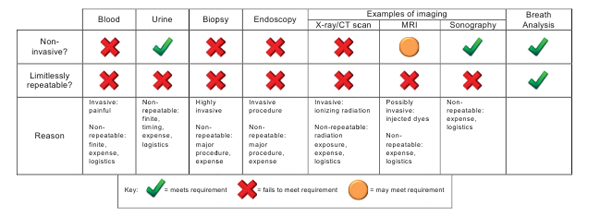Breath Analysis for Disease Diagnosis and Monitoring
By Phillip X. Braun, Claire F. Gmachl and Raed A. Dweik
NOTE: This is an overview of the entire article, which appeared in the November 2012 issue of the IEEE Sensors Journal.
Click here to read the entire article.
Exhaled breath analysis holds great promise for the development of noninvasive, frequently repeatable diagnostic and monitoring tools. (See Table below.) Recently there has been great clinical interest in breath analysis, considering its applicability to disease states such as asthma, renal failure, diabetes, and cancer.

Current widely-used medical diagnostic techniques, all of which suffer from invasiveness and/or practical restrictions on repeatability. Breath analysis, if it fully realizes its potential, will suffer from neither, enabling revolutionary diagnostic applications.
For clinical breath analysis to advance beyond its current state, however, much closer multidisciplinary collaboration needs to be not only recognized but also effected. The article reviews the current state of clinical breath analysis from the perspective of the challenges the field faces medically, technologically, biochemically, and in data interpretation. It addresses the need for collaboration, and the path from research to clinical practice.
In addition to pointing out the challenges, the article suggests a course of action for closer collaboration, better understanding, and more productive dialogue between these disciplines, including an iterative sensor development process that is integrated with clinical trials, formation of goals that transcend individual disciplines, creation of multidisciplinary research teams and a cross-disciplinary student exchange program, and collaborative funding options.
The article discusses in detail the medical challenges and reasons for optimism, the technological challenges, and the need for inter-disciplinary collaboration, especially in drawing on the expertise of the environmental exposure discipline within public health studies.
The medical challenges addressed are grouped into two general categories: 1) identification of biomarkers, defined as measurable characteristics which indicate either normal or pathogenic processes, and 2) confounding factors. They cite the need for both a top-down and a bottom-up approach to identification of biomarkers. The top-down approach attempts to determine biomarkers by identification of compounds, using appropriate sensing technology and careful experimental design, which differ in a statistically significant manner between diseased and healthy individuals. correlations. The bottom-up approach involves an investigation of disease metabolomics; specifically, determining the disease-specific products of individual pathologies which are subsequently excreted in breath.
Technological challenges center on the development of appropriate sensors. Indeed, an ideal sensor for clinical breath analysis needs to be compact, portable, room-temperature operable, user-friendly, highly sensitive (ppt ideal), highly selective, robust, precise, accurate, capable of real-time measurement, and inexpensive. Current sensor technologies are discussed. A variety of sensor technologies may be necessary. One class of sensors that seems especially promising in is based on mid-infrared (mid-IR) spectroscopy.
Throughout the article, the authors focus on developing a course of transdisciplinary action that is required to bring breath analysis into widespread clinical practice.
ABOUT THE AUTHORS
Phillip X. Braun received the A.B. degree from Princeton University, Princeton, NJ, in 2010. He is currently Special Projects Manager with the National Science Foundation Engineering Research Center Mid-Infrared Technologies for Health and the Environment. He has conducted medical and engineering research in the laboratories of the other two authors.
Claire F. Gmachl (SM’00) received the M.Sc. degree in physics from the University of Innsbruck, Innsbruck, Austria, in 1991, and the Ph.D. degree from the Technical University of Vienna, Vienna, Austria, in 1995. She is currently the Eugene Higgins Professor of electrical engineering with Princeton University, Princeton, NJ, and the Director of the Center for Mid-Infrared Technologies for Health and the Environment. Her current research interests include development of high-performance quantum cascade lasers and their applications.
Raed A. Dweik received the M.D. degree from the University of Jordan, Amman, Jordan, in 1988. He is currently the Director of the Pulmonary Vascular Program and a member of the Department of Pulmonary, Allergy, and Critical Care Medicine and the Department of Pathobiology, Cleveland Clinic, Cleveland, OH. He is a Professor of medicine with the Cleveland Clinic Lerner College of Medicine, Case Western Reserve University, Cleveland. He is board certified in internal medicine, pulmonary disease, and critical care medicine. His current research interests include exhaled breath analysis and the role of nitric oxide and other biomarkers in exhaled breath in cardiopulmonary physiology, lung pathology, and systemic diseases.






